Product-Centric, Customer-Centric, Relationship-Centric. What Should Brands Focus On in 2025?
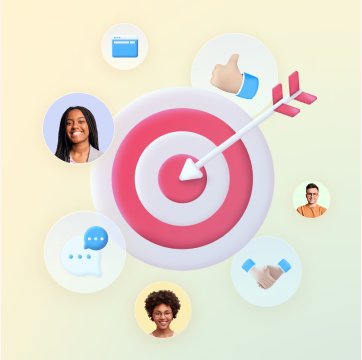
Table of contents
In 2016, the late Clayton Christensen, a renowned American economist, presented ‘The Jobs to be Done‘ theory in his book, Competing Against Luck.
The essence of his theory is quite straightforward: The building blocks of successful business innovation start with understanding the customer’s choice. The ‘why’.
Why did a customer choose to go with a certain product or service?
What were those differentiators that compelled the customer to choose a particular brand? Was it the product? Was it the service? Or was it how they were made to feel?
Simon Sinek, the famous inspirational author and speaker put forward the Golden Circle model during one of his insightful TED talks. A number of marketers swear by this model simply because it helps businesses define their value proposition.
And if you are familiar with the Golden Circle model, then you know how.
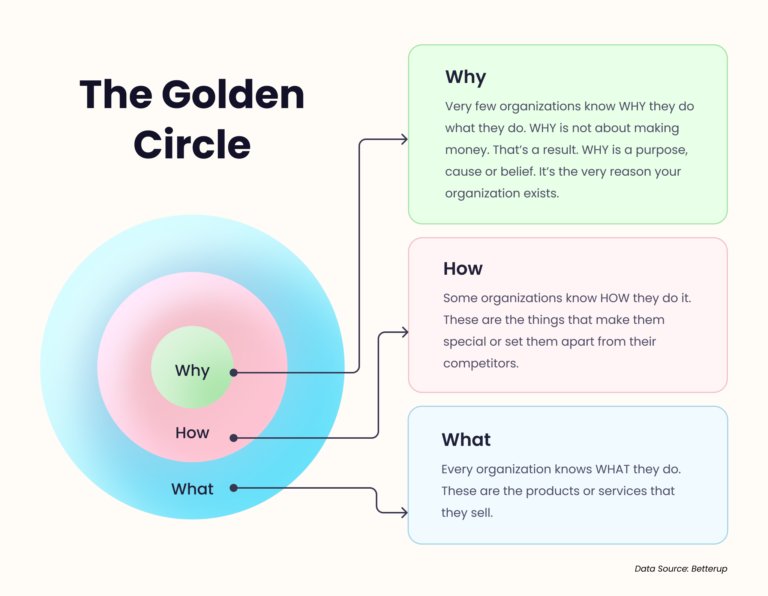
For the uninitiated, the Golden Circle model compels individuals or organizations to dwell on the ‘why’. This helps them define the vision and the mission behind what they do.
At its heart, both the Jobs to be Done and the Golden Circle theory focuses on the most important question that is essential for innovation and growth.
And in an era where customer choice is the key driver for success, brands need to focus now more than ever on ‘why’ a customer should and would choose their product or service over their competitors.
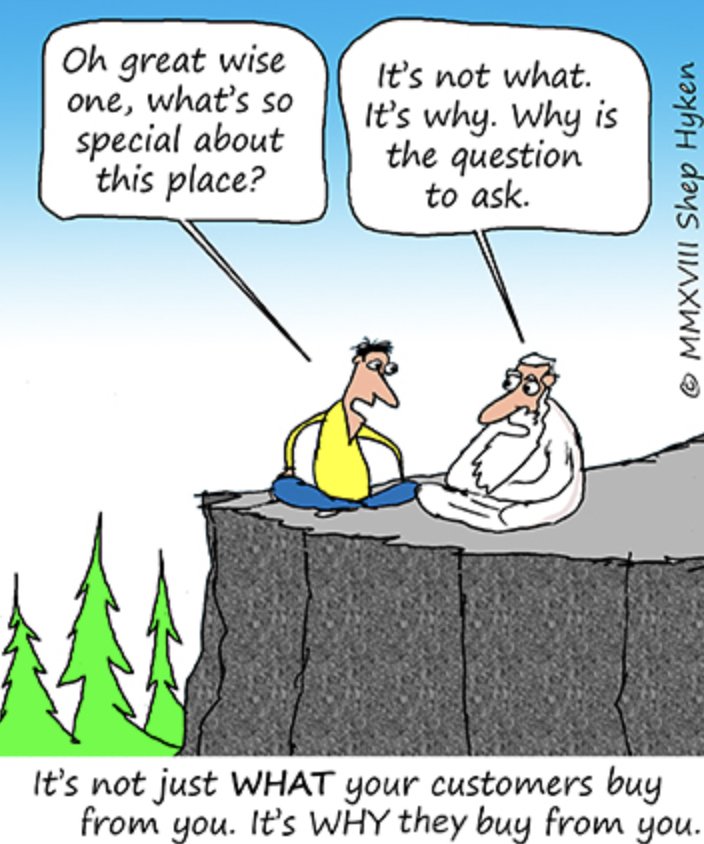
Defining the why is important because it allows brands to establish a human connection with their customers.
For instance, Huggies, the popular diaper brand defines their brand purpose as – “helping to navigate the unknowns of babyhood.” In doing so, the brand goes beyond the product it sells. Rather, it celebrates parenthood and demonstrates that they empathize with new parents.
Creating a human connection allows you to build experiences where customers truly feel valued and understood. It contributes to great customer experiences and research by SuperOffice shows that 86% of buyers are willing to pay more for a great customer experience.
So now, the question is how do you define your ‘why’ and how can you ensure that it adds up to a more holistic customer experience?
Table of Contents
- Defining the ‘why’
- Product-centric approach
- Customer-centric approach
- Relationship-centric approach
- Relationship-centricity: Welcoming a new era of business growth
- 5 key factors to building lasting customer relationships
- Final thoughts
- Pave the way for great customer support with Hiver
Defining the ‘why’
Take some of the popular brands that we know. Apple, Amazon, Ikea.
Let’s take a look at why these brands have become somewhat of a cult favorite.
A lot of times people don’t know what they want until you show it to them.
Steve Jobs, Founder, Apple
Apple – The company has designed an ecosystem that is elegant, unique, and efficient. Apple products are positioned as being built for creators and enthusiasts. They are laser-focused on product design and innovation and that’s their ‘why’. Customers are drawn to buy into the Apple ecosystem because of the user experience, innovation, and quality associated with Apple products.
We’re not competitor obsessed, we’re customer obsessed. We start with what the customer needs and we work backwards
Jeff Bezos, Founder, Amazon
Amazon – Amazon’s mission statement is quite interesting – “to be Earth’s most customer-centric company”. And the e-commerce giant achieves customer loyalty through varied pricing, a wide selection of goods and services, and convenience. Amazon’s mission statement clearly points out the fact that their ‘why’ is to satisfy customers. They believe that customers always want better and delighting them is the key to invention.
Cars are driven by people. The guiding principle behind everything we make at Volvo, therefore, is and must remain safety
Assar Gabrielsson & Gustaf Larson, Founders, Volvo
Volvo – The luxury vehicle brand has a dedicated child safety program running since the 1970s that focuses on building unique systems not just for the safety but also for the comfort of young travelers. In a recent move, they even partnered with LEGO in an effort to teach children about basic vehicle and road safety. Clearly, for Volvo, their ‘why’ isn’t merely about building luxury vehicles. It is defined by their dedication to building trust by focusing on the one thing that truly matters for their customers – the safety of their loved ones.
All three of these brands focus on different strategies for business growth. For Apple, the focus is on the product and ecosystem. For Amazon, it is about the shopping experience of their customers and customer satisfaction. For Volvo, it is about fostering customer loyalty.
To get slightly more technical,
Apple is what we call a product-centric company.
Amazon is what we refer to as a customer-centric company.
Volvo is what’s known as a relationship-centric company.
While all of these approaches have been working quite well for different brands, the question is which approach is best suited for your business?
To find out, it’s important to understand these approaches a little better.
Product-centric approach
In the product-centric approach, the main focus of a business is on its product rather than the customers themselves. Product-centric companies aim to constantly innovate, upgrade, and advance their offerings. It is based on the notion that an innovative and robust product can penetrate the market and create a need that was previously not there among customers. To succeed, efficient product operations are key, ensuring smooth development and quick adaptation to market changes.
Customer-centric approach
A customer-centric company focuses its efforts on understanding what the customers need and then developing products or services that can cater to these needs.
Customer centricity is a culture of putting the customer at the center of everything you do
Brian Solis, VP-Global Innovation Evangelist, Salesforce
A customer-centric business focuses on creating effortless and consistent experiences for customers across multiple channels and touchpoints.
It’s about understanding your customers, combining it with customer relationship management to collect behavioral and engagement data, and then identifying relevant opportunities to wow them throughout their customer journey. The customer-centric approach makes customer satisfaction a top priority and treats customer feedback as the holy grail.
In this approach, companies keep an eye on business growth by tracking customer success metrics such as churn rate (the rate at which customers stop doing business with a company),CRR (customer retention rate – the percentage of existing customers retained after a given period),NPS (Net Promoter Score – a measure of customer loyalty derived through customer surveys),and CLTV ( Customer Lifetime Value – a measure of the revenue brought in by a paying customer).
Relationship-centric approach
The relationship-centric approach takes into account aspects from both the product-centric as well as customer-centric approaches. As the name suggests, the relationship-centric approach focuses on any and all efforts that go into building lasting, loyal relationships with customers. It requires both innovation in product development as well as a customer-focused approach to doing things.
The relationship-centric approach is about truly making a difference in the lives of customers. It is about building emotional connections and showing that you care.
Here’s a quick comparison of the three approaches in a nutshell.
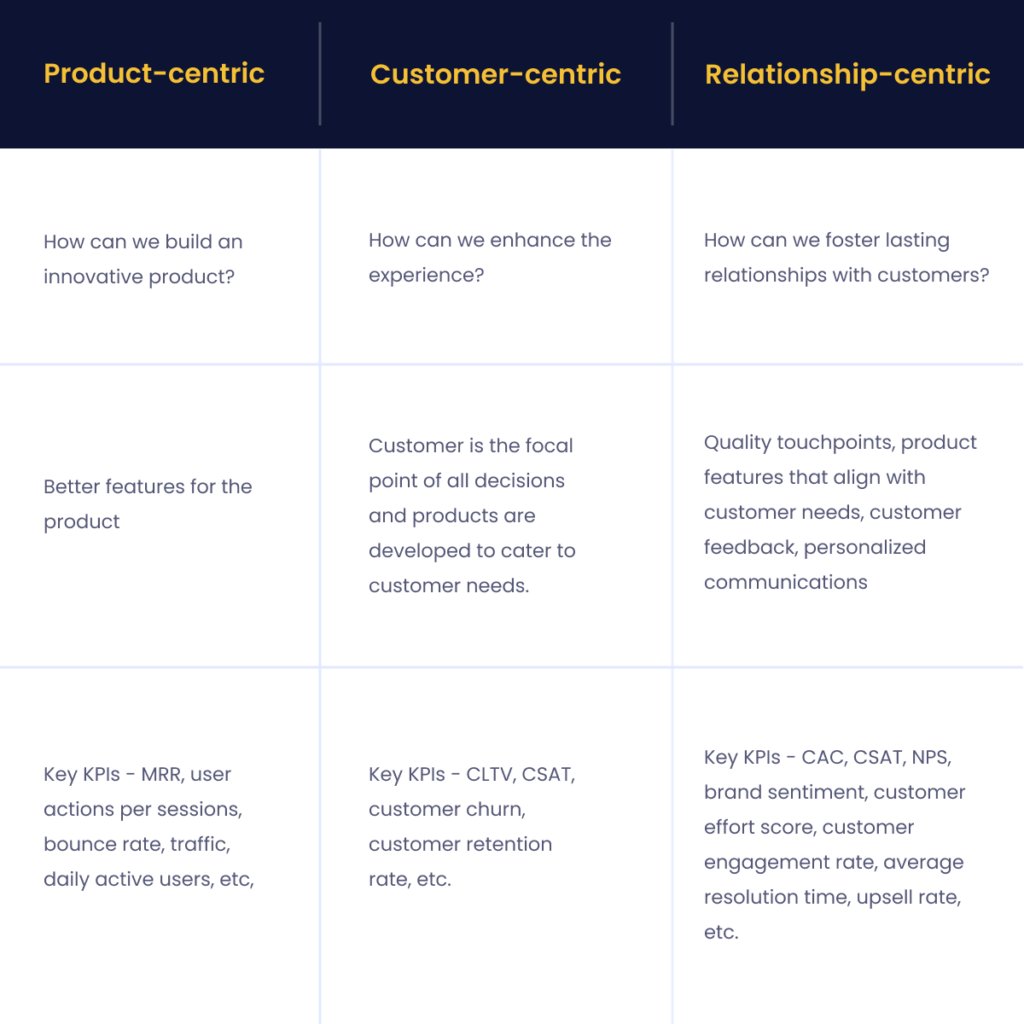
Relationship-centricity: Welcoming a new era of business growth
Now, which approach do you adopt for your business?
While there are some great examples of both product-centric and customer-centric approaches, the problem is that they can get quite myopic in their approach after a while. In today’s competitive marketplace, the companies that stand out are the ones where customers feel truly valued.
And this is why companies today need to focus on building customer relationships.
At its core, the relationship-centric approach emphasizes that customers are humans just like us and are looking for relatable, empathetic customer experiences.
In fact, if we put ourselves in the customer’s shoes, it’s easy to realize how relationship selling is evident in our everyday life. For instance:
We prefer going to the same salon where the staff knows your name and what you need.
We love ordering from the restaurant where the friendly manager makes sure to serve an extra helping of fries.
We recommend the same car dealership company every time simply because you know they will go out of their way to make the buying experience comfortable.
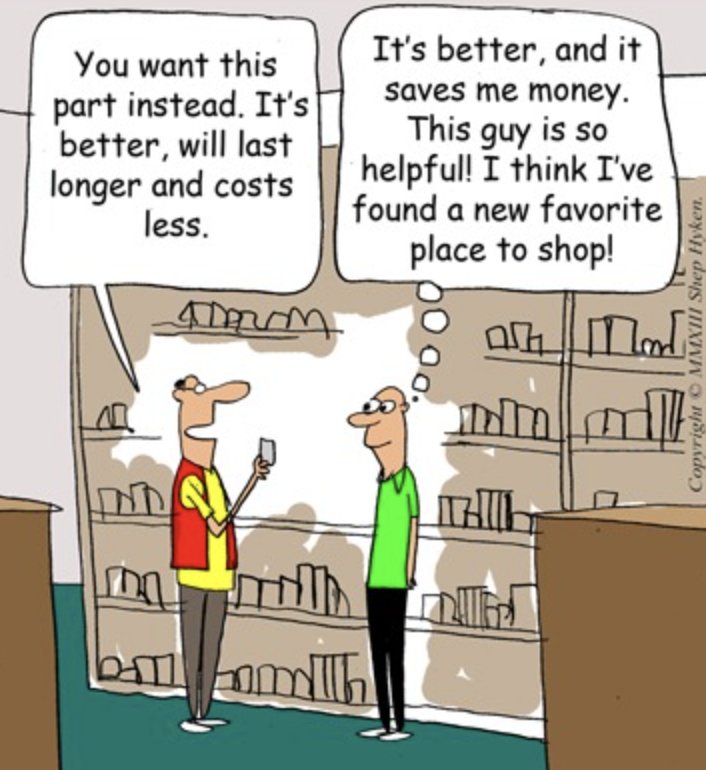
And in the era of choices, the rapport and trust you build with your customers are what will give you a headstart over your competition.
5 key factors to building lasting customer relationships
Building strong customer relationships is about optimizing all experiences and interactions that a customer has with your business. From when they hear about your brand to when they decide to purchase from you to what happens after the sale has been completed. Creating and sustaining these relationships is the key to successful business growth.
So, how do you achieve this? Here are some important strategies to keep in mind.
1. Be where your customers are
Effective customer communication goes a long way in engaging your customers. It plays a key role in understanding what your customers need and creating effortless customer experiences.
A huge part of successful customer communication hinges on customers being able to reach you with ease on channels of their choice. These include email, social media, website, events, live chat, and more. Having a multi-channel communication strategy in place ensures that your company is available wherever your customers are present. This makes their lives much easier which is what relationship-centricity is all about in the first place.
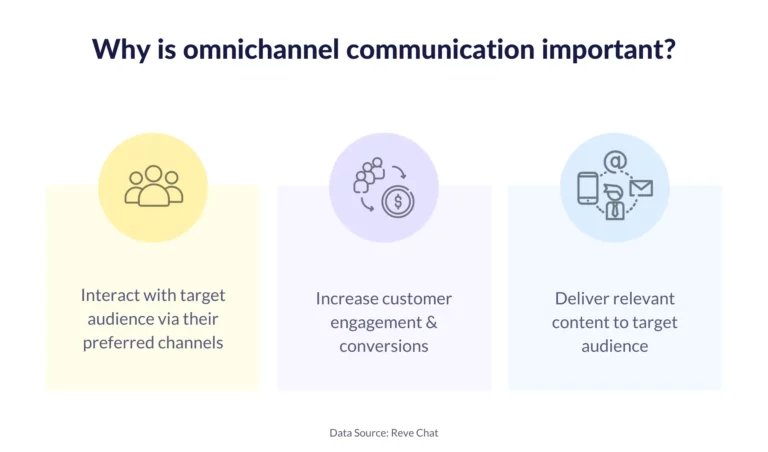
2. Listen, listen, and… listen!
The phrase ‘customer-first’ is a tall claim. The phrase is often splashed across advertisements, billboards, and brochures like nobody’s business.
However, the reality is quite different. A survey by HubSpot found that nearly 42% of companies don’t listen to their customers.
That’s a grim stat.
Listening to your customers is among the most important pillars of being a relationship-centric company. How else are you going to be able to understand your customers better?
Gathering customer feedback is also important in understanding your own product or service better. It helps you come up with ideas on how you can add value to customers, and how to better cater to their specific needs and build better and more well-rounded customer experiences.
Apart from collecting customer feedback via surveys, there are plenty of other ways to find out what your customers feel about your brand. Some of these include social listening, one-on-one interactions whenever possible, forums and communities, product engagement metrics, and focus groups.
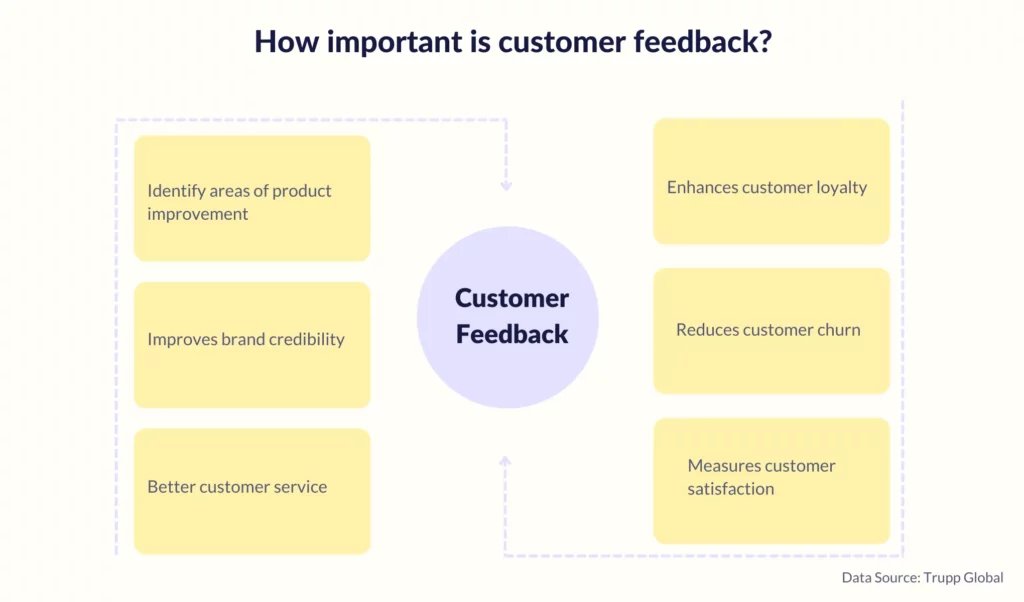
3. Design experiences that delight your customers
According to a research report from Mckinsey, companies that excel at personalization generate 40% more revenue than companies that provide run-of-the-mill experiences.
Fundamentally, humans are always drawn to situations that offer memorable experiences. And personalization enables brands to achieve just that. Creating a lasting impression allows customers to remember you and helps foster brand loyalty.
Personalization is not simply about sending an automated thank youmessage at the end of a purchase. Rather it could include gestures like sending gifts on a customer’s first purchase, offering incentives and discounts, remembering important dates/moments in the customer’s lifetime, and so on.
What matters is thoughtfulness, consistency and being available during the different stages of your customer’s journey.
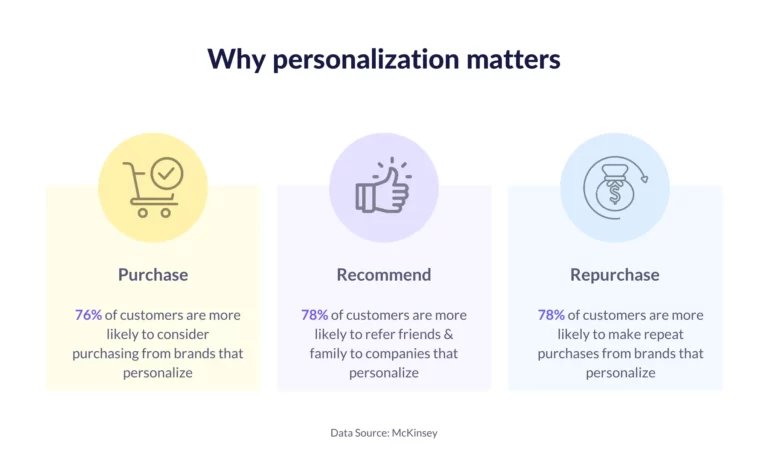
4. Study customer behavior through segmentation
Just like personalization, customer segmentation has a very important role to play in enabling a business to be relationship-centric.
To deliver experiences that are truly tailored to your customer’s expectations, you need to first segment your customer base – both current and potential – into smaller groups. This gives you a bird’s eye view of the similarities and differences between them.
Segmentation can be done on the basis of demographics, product usage, designations, requirements, lifestyle, and more.
The bottom line is simple – get to know your customers as much as possible. Once you are able to segment your customers, it is easier to personalize messaging and target them with highly tailor-made campaigns.
That being said, customer segmentation requires thorough research, and the ability to make inferences based on buying patterns, feedback, analytics, and several other factors.
5. Anticipate your customer’s needs
Most of us are familiar with the adage – Prevention is better than cure.
Well, proactive customer support is something like that. It is all about sensing what your customer needs and then proactively reaching out rather than waiting for the customer to ring the alarm bells.
Being proactive with your customers directly impacts how they perceive your brand. A positive brand perception creates brand advocates. Case in point, 92% of respondents in a customer survey by HelpLama revealed that they had a positive perception of a brand when contacted proactively.
Apart from that, proactive customer service stops minor issues from becoming full-fledged support issues, saving time and effort for your support agents and also helping them reduce their workload.
Proactive customer service can be achieved through periodic customer follow-ups, timely surveys, and keeping track of customer behavior, product usage, and more.
Final thoughts
Relationship-centric companies present the way forward. They are much more capable of surviving fluctuations in the market.
A study by McKinsey shows that stakeholders in companies that try to deepen their understanding and demonstrate empathy towards customers have been proven to receive 4x higher returns over a ten-year period.
Prioritizing your customers and placing customer relationships at the core of your business enables you to build a strategy that can set you up for long-term growth.
Pave the way for great customer support with Hiver
One of the most crucial steps in building a relationship-centric business is being able to provide your customers with top-notch, empathetic customer support.
Your support agents play a very important role here, engaging with customers, and enabling them to understand your product or service deeper. And it is important to equip your agents with the best tools that can empower them to do their jobs efficiently.
A customer support solution like Hiver enables your frontline agents to communicate with customers across multiple touchpoints and foster better customer relationships.
The best part about Hiver is that it works within Gmail’s interface. That means your support team doesn’t have to spend extensive time and effort learning new software.
Additionally, Hiver ensures customer queries are seen as real problems, and NOT as ticket numbers. This, further, makes it possible for your support staff to understand customers, have more natural conversations with them, and get to the bottom of their pain points.
Schedule a demo with Hiver today and take your first step towards building meaningful customer relationships.

































